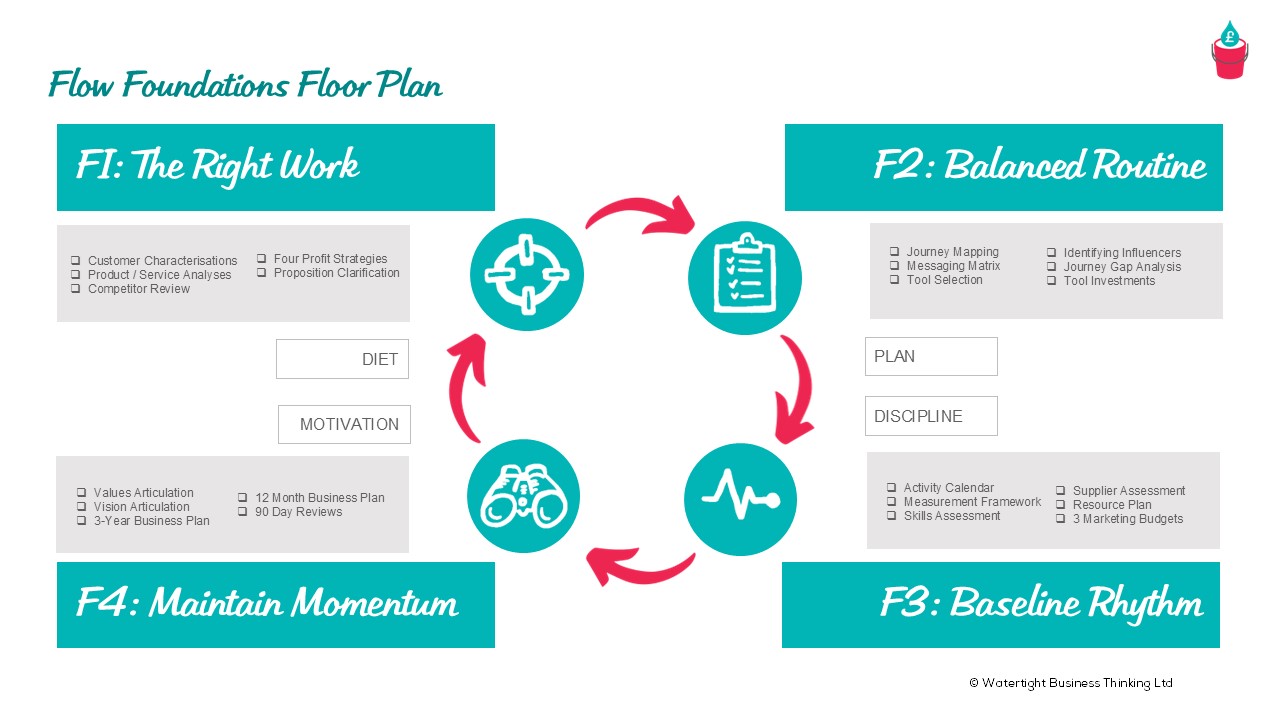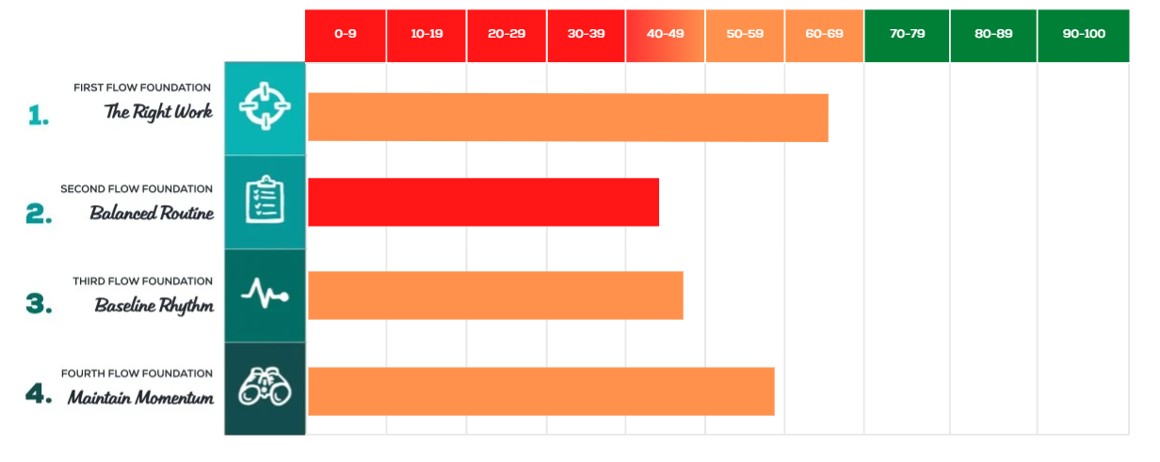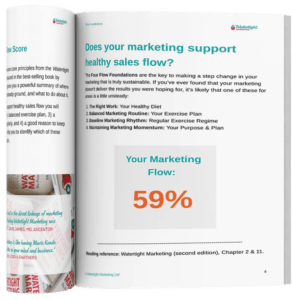Reading Time: 10 Minutes
Listen to the session podcast here
54-minute roundtable sharing and chatting about the findings of our latest research.
The starting point for our research is the Flow Foundations floorplan. This floorplan is a way of organising the marketing operation to make sure that tactics are aligned to strategy and both support the business plan.
The Four Foundations are:
- The Right Work: where you find projects such as understanding your market and competitors, crafting your propositions and being really clear about the kind of work and customers you want more of.
- Balanced Routine: this is where your marketing planning sits, journey mapping, getting your messaging right, choosing the right tools, finding your influencers, gap analysis and investing in those marketing tools and techniques that support the sales journey.
- Baseline Rhythm: this is all about activity planning, measurement, resource planning and budgeting.
- Maintain Momentum: includes strategic projects like values and how these are articulated, vision and breaking down the business plan into short, medium and long-term chunks.

High and low scores
As was true last year, no one Foundation scored ‘excellent’ overall. The highest scoring Foundations were the two strategic ones (First and Fourth Foundations) with the Right Work rated higher than Maintaining Momentum. The lowest scoring Foundation – even as scored by marketers – was the second, Balanced Routine. This was true on average for all respondents in all roles and in all business sizes. What this means is that there is a general lack of marketing planning that supports the sales process.

Not far behind is the third Foundation, Balanced Routine. The fact that this is higher than the second means that people are doing the marketing but not to any plan! The implication of this is twofold: they’re wasting money on marketing and they’re doing so on activities that might well not be having any impact.
The missing pieces
We’ll be shining a light on more detail when the research is published. For this session we shared four key gaps.
- Only 41% of respondents felt crystal clear about what they were selling to whom. Whilst many companies have defined what work and clients are profitable and motivating, fewer use those definitions to qualify enquiries.
- A minority of businesses have a marketing tool mapped to every step of the sales journey. This means that prospects are walking away for the lack of something that would better engage them and help encourage them to buy from you.
- Just under 40% of people match their marketing to the speed at which people make decisions. There’s a tendency to try and speed people towards a decision when they need more time and information.
- Teams are generally not clear on the vision and plan. This points to a communications gap: the board and management team might be well aware of the business’s plans; the wider business often is not, or at least in a way that means something to them.
Trends in the data
Three trends stood out.
Firstly, the gap between knowing and doing. The questions around comprehension (“we know this”) scored higher than practical application (“we do this”).
Second, many businesses have a wobbly table – i.e. their strategic Foundations score higher than their operational ones. This is good news in the sense that people are generally motivated by the vision and plan and are clear on the kind of work which is good for the business. However, the marketing operations do not match up to this and so do not support business plans well.
Third, as was true last year, there’s a real opportunity to improve the loyalty and longevity of existing customers. Questions around these areas consistently scored lower than those concerned with sales or what is traditionally seen as marketing – creating awareness and lead generation.
Why is marketing planning scored so low?
Rachael Wheatley: There are a couple of reasons I can see. Time – people are busy, juggling lots of plates and it’s hard to carve out time for planning. And there’s still a tendency to look for quick wins and so that’s what marketers (rightly or wrongly) focus on. To show the value of marketing is often about doing the visible bits and getting stuff done, rather than pausing and thinking about the right things to do.
David Perry: It’s the urgency of the operational, tactical-related issues. That’s got to be done that day. A strategy can always be done tomorrow. And if you’re not careful tomorrow never comes.
Bryony Thomas: That’s a time horizon issue again. There’s a chart that I’ve used before I look at time horizons by role. The salesperson looks down at their bonus window. The marketer looks out towards a 12 month window. It’s a tension between short term and long term.
David Perry: It also depends on the degree to which you have control over your own time. If you are at the beck and call of another, whether that’s someone further up the management chain, or clients that are banging on your door, it’s almost impossible, especially if you’re in a small business or small team, to turn them away.
Bryony Thomas: So really being protective of planning time, blocking out and making it immovable.
Bruce: A lot of it comes down to an philosophical debate: what is strategy? Most marketers don’t do strategy, they do tactics. Which means they don’t see the direction of travel. They focus on outputs, not outcomes.
Helen Trudgeon: I think time is the biggest issue. If you’re on a small team and you’re doing both strategy and execution, strategy gets thrown out the window as soon as you need to get things done. When you push back, and say: we need to fit this in with the strategy, sometimes that works, but other times it doesn’t. The response is often no, just get it out the door, even if it doesn’t fit within that plan that you’ve put in place.
Bryony Thomas: That’s key, isn’t it, making sure that you’ve got genuine buy in and that you can develop a relationship where you can say: I really appreciate that thought but I don’t think it’s going to be the right thing to do so I’m going to put it onto my agenda to think about in my next planning window. It’s one of good things about the Touchpoint Leak® assessment where you can say: the idea you’ve just given me does this job and actually, we already have something really effective that works.
Helen Trudgeon: For that to work, you need to build up that trust with the team so they trust you when you push back and say no, that’s not going to work. That takes time.
Bryony Thomas: Yes, and if you’re a solo marketer in a business but you only have a couple of years’ experience, that’s hard to do. Harder still with remote working because marketers don’t learn from colleagues in the same office as would have been true previously. Perhaps younger marketers can’t learn and listen so easily because they’re not around others.
Bruce: I think a lot of the time, marketing people have got to do a sales job internally about why marketing planning needs to be done.
Why do MDs rate marketing as less effective than the marketers rate it?
Rachael Wheatley: There’s a distinct perception gap here. I wonder whether it’s a difference in expectations. Talking to senior marketer recently, we had a discussion about value. Her CEO is not seeing the value of the marketing that she’s doing. She’s doing some good things, creating relevant content and on-brand messaging. But what others expect of marketing is not necessarily the same as what we perceive as the value of marketing. I think it also comes back to time horizons as well and what people expect from marketing in what timescale – usually more quickly that it can deliver!
Bryony Thomas: Horizons are so important. If marketers are doing some really good awareness activity, that’s unlikely to pay you back in a B2B scenario in a short period of time. There are scenarios where things move faster, but usually you won’t see results for six, nine, twelve months down the line.
Rachael Wheatley: That talks to the need for marketers to get ahead of the metrics and point to that time horizon. You can then say: our normal sales cycle is 18 months, so we’re not expecting results the awareness activity we did last quarter until next year, but we can track the progress of prospects over that period of time.
Helen Trudgeon: In one role I had, the MD/business owner didn’t want marketing and fought against it for a very long time because he saw it as a waste of time. He wanted to focus on sales. He was finally persuaded by one of his business partners to bring in me to set marketing up and get the ball rolling. Within the first few months, he turned around and apologised and said: I’m really sorry – I didn’t realise you’ve actually done a great job and I can now see the value of marketing. We all felt very validated, and part of that was being able to use the right metrics to show what was going on and to connect marketing to the sales cycle and measuring marketing qualified and sales qualified leads.
Bryony Thomas: There are marketing tools to support customers all the way through the process, but you do need to measure the whole journey to know whether the upstream activities are working.
Watertight Wisdom
Five key actions
- Get close to board colleagues. Your first audience is an internal one. Use visuals, metaphor, examples to bring marketing to life and show its value.
- Put strategic marketing on the board agenda. Use the Foundation floorplan to help you do this. Let the board and your colleagues know what you’re doing and why, which projects you’re focusing on and when and whether they’re red, amber or green.
- It’s never been more important to build a relationship with the MD.
- Focus on opportunities within existing clients. Don’t get totally distracted by lead generation as your sole purpose in life; look at the opportunities with existing and dormant clients.
- Gain a deep understanding of the customer’s decision journey. It’s only when you understand those steps that you can choose the right tools to support the journey. You only need an approximation of a pretty good journey first.

Rachael Wheatley
Managing Director, Watertight Thinking
Rachael brings over 30 years’ of marketing experience, with a particular focus on building and developing effective marketing teams that are able to act as a strategic driving force across an organisation. She has worked with Watertight since 2014 as a Master Practitioner and joined the business as MD in 2022.



